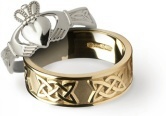Impressions of Ireland Symbols Explained
Dolmen
Many such pre-historic grave monuments are found throughout Ireland. Burial deposits have been excavated at some of these and suggest that the dolmens may be as much a six thousand years old.
Newgrange
This is the famous engraving in the chamber at Newgrange, Ireland. Newgrange is the oldest megalithic structure in Europe which is known for certain to have had an astronomical function. It is aligned with the Winter Solstice, as it would have occurred more than 5,000 years ago.
Ogham Stone
These standing stones are found all over the South and West of Ireland. The inscriptions are cut into the edge of the stone using the ancient Ogham alphabet. They date from about 300 to 500 AD, but it is thought that the alphabet may actually have been used much earlier, being carved on pieces of yew-wood and that it was a sacred alphabet used by the druids.
St Patrick
For the Irish people St. Patrick has always been the focus of our Christian faith which he did most to establish in Ireland. He is also the author of our oldest surviving manuscript. St. Patrick used the shamrock to explain the Christian Trinity. Legend also has it that he banished snakes from Ireland.
King Sitric
Sitric “silkbeard” was the Norse King of Dublin who issued the first Irish coins - silver pennies about 995 AD. He had an Irish mother and he married a daughter of Brian Boru. He founded Christ Church in Dublin.
L for Literature
From the early myths of spoken literature, the medieval manuscripts, the poems and songs of the Irish bards, right up to our own times with Joyce, Yeats, Beckett, O’Riordan, O’Cadhain, Heaney and many others, the Irish have excelled in literature in Latin, in Irish and in English.
Castle
Wherever they went in Europe, the Normans built castles and Ireland was no exception. They also built abbeys, churches and friaries. All over Ireland Norman castles and keeps are found, some in ruins but some still in use at the present day.
Celtic High Cross
An even more distinctive feature of the Irish countryside and dating from an earlier century are the magnificent High Crosses of Ireland. Intricately carved with animals, birds, Celtic designs and detailed scenes from the scriptures most of them have the stone circle which, like the Roman laurel wreath, is a sign of victory, Christ’s victory over sin and death.
Salmon
In Irish folklore the salmon represents wisdom. The salmon appears on our coinage and Irish Salmon is famous for its flavour and texture. The legend of the Salmon of Knowledge tells the story of Fionn MacCumhaill and symbolizes Ireland’s legendary heroes and our island heritage.
Horse
The central plains of Ireland are ideal for rearing horses. The open grazing gives them strong bones. The Irish have always excelled as breeders and trainers and Irish horses are sought throughout the world for show-jumping and racing. Irish sport stars have performed with great honor in our national sports and international sporting events.
Harp
The Irish harp is a beautiful instrument and is an official symbol of Ireland appearing on Government papers. For the early monks it symbolized David the author of the psalms while the great Gaelic harpists carried our Irish traditions on through troubled times. Ireland’s musical heritage is renowned worldwide in terms of music, lyrics and dance.
Ireland
The map of Ireland is dear to all Irish people. The first known ‘Map’ of Ireland is part of a larger map printed in 1482 now in Congress library in Washington. It was constructed from the latitudes and longitudes given by Ptolomy in his work “Geography”. Ptolomy was a Greek mathematician, traveler and geographer who lived from 90 AD to 168 AD. He gave excellent accounts of Ireland in his work and his map is very recognizable today.
Gaelige
The gaelic language is one of the two official Languages of Ireland and is recognized as such by EU. It was probably brought to Ireland by the invading Celts from Europe and developed its own distinctive form. It is currently having a revival as a spoken language among Irish people abroad.
